China won the trade war with the US. Business trumps politics, and China is a cornerstone of the global economy

Despite years of attacking China with sanctions and tariffs, and bragging about how ‘easy’ it would be to win this trade war, Trump has failed to impose Washington’s terms on trade relations with Beijing. Here’s why.
China’s latest trade data reveals a record trade surplus. Fuelled in part by pandemic demand for medical equipment and electronics, Beijing’s surplus over the United States also increased by 7.1% creating a widening gap of $316 billion for the year 2020. This came despite the Trump administration having devoted most of his term waging a trade war against China and slapping tariffs on imports from the country, with a strategic goal of “shifting supply chains” either back to the United States or to more friendly partners.
Whilst indeed the impact of this saga has seen the United States drop from China’s first to third largest trading partner, overtaken by Europe and ASEAN, it ultimately hasn’t changed the tectonics of Beijing’s dominance over global commerce or for that matter even America itself. Why so? Such changes are easier said than done. China’s supply chains remain more cost competitive, resilient, interconnected and buttressed by local demand more than anywhere else on Earth. Some of the countries that have been touted as alternatives, such as India and Vietnam, do not have the capacity to replicate this on a short-term basis. On this issue, business incentives continue to “Trump” political ones.
Supply chains are not a wooden pop-up shop which can be assembled, taken down and shifted anywhere overnight. The clue is in the name, a supply chain is not a “single factory that makes X”- it is an interconnected network of various factories, providers, associated businesses, assemblers and infrastructure points which are located in a concentrated geographic space. This network is not automatized, but co-dependent. Affordability, reliability and efficiency are key in creating a successful supply chain. For example, why does nobody invest to make MacBooks in let’s say, Greenland? Apple could build a factory there, right?
Also on rt.com A former Australian general has forecast a war between China and America will happen ‘within 3-5 years’. Is that really likely?That’s not how it works. You don’t build a MacBook in a single factory. They might get assembled in a factory, but who makes the circuits? Who makes the screens? Who makes the processors? And how do you keep all these parts close together and intact so that you get your product out quickly without facing disruption to markets? Do you think somewhere far away, remote, without infrastructure and without a meaningful market such as Greenland is a good alternative? Of course not. You don’t simply have a factory; you have a supply chain which is a web of enterprises all in proximity. And as it happens, China dominates many of these worldwide.
Why? First of all, China’s sheer size and population has created an abundant labour force, coupled with competitive infrastructure, that makes it more affordable than anywhere else in the world. Secondly, China’s own domestic market size and cheaper costs mean local demand is very high and therefore this makes it easier for a business to pass a profit margin. Thirdly, because China has already set itself up as the global hub of trade and commerce for decades now owing to these factors, this consolidates its position and global demand subsequently makes supply costs even cheaper. It has long been a win-win scenario for businesses.
Although Vietnam and India have been repeatedly touted as alternatives, for now these countries do not have the competitive or capabilities edge to take on China meaningfully. For example, whilst India has 1.3 billion people and a more affordable labour force than Beijing, it does not have the infrastructure or development level to replicate China’s success in the short term, nor does it have the consumer market size. It has potential, but that’s about it for now. Businesses may see India nonetheless as worth investing in, but only for what it itself offers rather than a global alternative to China. Recent factory riots at Apple’s complex in Bengaluru also demonstrated the risks of instability.
Also on rt.com China’s economy predicted to outgrow US’ by 2028 – ironically, Trump’s trade war & Covid response only speed that process upSecondly, Vietnam. Hanoi’s economy represents China at an earlier stage, a Communist State which is entering a phase of rapid growth and booming. Its labour force is also cheaper than China’s. For some simple goods, such as low-end plastics and fabrics, it is more convenient for businesses to invest here, as we must consider the argument that as China develops, the type of manufacturing it excels at also evolves accordingly. Nonetheless, it is a country which is much smaller than China and cannot possibly replicate its entire manufacturing and industrial capacity on a global scale.
In this case, it should be no surprise that for all the rhetoric about decoupling and supply chains shifting out of China, that isn’t happening. Beijing dominates global supply chains not through some grand conspiracy to steal American jobs, but simply because what it has to offer is more competitive than everyone else and projects such as the Belt and Road initiative, establishing the Europe-China Railway and other grand projects, have only consolidated that. Western manufacturers will also never remove their presence from the country because China’s own market is too much of a pull. So even if they diversify into other countries, they’re ultimately staying put.
Given this, Donald Trump’s trade war has not fundamentally rewritten the paradigm of China-US business relations. China remains a central component of global supply chains, despite the tariffs he has implemented, because there are simply no feasible rivals or alternatives. Supply chains ultimately operate on affordability, geography and convenience, not on a preference of politics. India is one country that has the potential to do so, but that’s some time away yet.
Think your friends would be interested? Share this story!
The statements, views and opinions expressed in this column are solely those of the author and do not necessarily represent those of RT.














